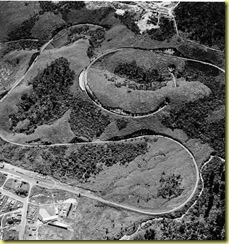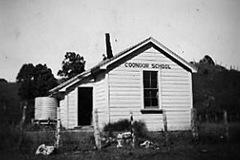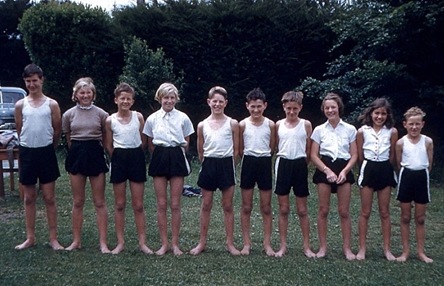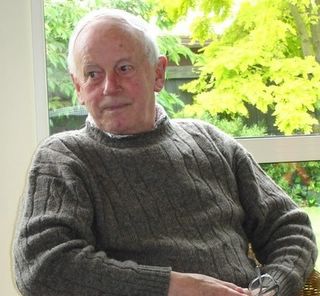(text first published in Whanganui River Annual 2001)
I can never forget 1947. Leaving my hometown of Dunedin and heading for my
first country school, I was bright-eyed and bushy-tailed, as they say, full
of the crusading eagerness of youth.
As Ethne Davidson had discovered before me, it was certainly "in the country".
Unlike Ethne, I stepped down from the Limited at Raurimu with no-one to
meet me, and spent the night sitting on a little cane-backed chair in the station,
only to be awakened every time a train came through a neighbouring station by
the dead-awakening clanging of the tablet machine alarm. I can still see the
top snowclad face of Ruapehu shining in the moonlight for hour after hour.
Raurimu Spiral :Photo taken 24/1/57 by Whites Aviation.
(Permission of the Alexander Turnbull Library necessary before re-use of this image.)
Like one of the Annual's earlier contributors, I knew that it was a mere
40k to Whakahoro, but the mailtruck had covered almost 200k up every side
road, to every mailbox, to every cream stand, by the time Mousie Shaw pointed
across the
Retaruke and said, "There's where you'll be staying!" It had been
a 5-hour trip! And as he eased the truck up the gentle slope toward the
farm gate, I saw the Hayes family, all except Mum, waiting to meet "the new
teacher". Old Fred himself, complete with a long piece of grass hanging from
his mouth, a week or more of black stubble all over his tough and experienced
face, was perched on the gate itself, with the kids on the grass in front of
him. "We're a bit rough and ready," he barked, "but just take us as you find
us!"
The kids loaded my trunk onto a home-made barrow, and were clearly eager to
show me the bridge, the like of which I had never imagined, let alone
encountered. It was a swingbridge about 30 metres above the water, and more
than 30 metres long. The huge rectangular uprights looked pretty solid and
permanent, and at first glance the "cables" appeared to be about 50mm thick,
and well able to take the load. Closer examination showed that each cable was
in fact a bunch of No. 8 or No. 10 wires held together at intervals. Freddy
used to joke about it, saying that you'd have plenty of time to get off the
bridge if they went, as you'd hear each wire snapping in turn "ping - ping -
ping -...", and the kids would shriek with laughter and take up the tale.
But the worst aspect of the old bridge at that time was the neglected
decking. Fred had renewed a few vital planks, but while I was there about a
third of the planks were lying in place without being nailed down, so that
you dare not stand on one end of a plank. Another third were properly fixed,
and the remaining third missing altogether. The views one got through some of
these gaping holes of the wet papa boulders below were enough to send a new
chum into a quivering mess. The Hayes family delighted in telling me that
Bill Lacy, well over six feet and with the typical Lacy assertiveness,
actually crawled the last metres of his first crossing. I wasn't much better,
as the kids galloped ahead of me with the laden barrow, causing the bridge to
buck and weave, and the city lad wondering why he had ever volunteered for
country service!
Mrs Hayes welcomed me like a son and a guest, and I was the only one who
slept with sheets. The boys slept on the verandah, sheltered by some
makeshift sacking nailed between the verandah posts, and for extra bedding, a
cow cover or two, and they were quite happy with that. After I'd been
boarding there a few weeks I could cycle down the drive, down the twisty
track, onto the bridge, then stay three planks from the right to halfway,
cross the bridge, then stay three from the left to complete the crossing. I
couldn't always stay on the bike up the muddy track to the road, but the
bridge was no longer a worry. Years later, of course, the old bridge
collapsed while two of the Hayes boys were taking a mob of sheep across, and
it was actually the tall timber supports that failed in the finish, rather
than the wire cables.
The little prefab school was still quite new when I took over. The nine
children, four Hayes, two Lacys, two Wilsons and one little Dobbs, lined up
outside to say "Good Morning", and I heard for the first time the refrain
that was to be repeated for more than a month, "This is how Miss Dron did
it."
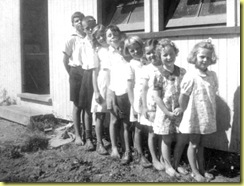
Whakahoro School 1947:
Don Wilson, Bob Hayes, Jill Hayes, Bunny Lacy, Rodney Hayes, Isla Hayes, Clare Wilson, Claire Lacy, Jenny Dobbs
We had a rough rugby post out on the paddock which ended at the
Whanganui River bank, and Bob Hayes would kick goals with his bare feet.
The Hayes kids would walk, or ride the pony, three miles to school, while
the others lived quite handy. The Lacys lived across the Retaruke, and had
to walk up to the traffic bridge that figures in your 2000 issue. It was on that
little piece of road that I saw some wonderful glow-worm displays as I walked
home to Lacys when I boarded there. Bob and Jill Hayes, in particular, taught
me volumes about nature, knowing all the native trees, and Bob could even
show me the glow-worms during the day!
Every weekend I would be invited to go "pig-untin", and I held out for a
while on the grounds of not being very keen to kill things anyway. I was a
teetotaller too, fresh from my Methodist adolescence, and again the Hayes
kids roared aloud so honestly when I first said "Don't touch the stuff
actually." Fred Hayes' reply, "You will before you leave this place!", turned
out to be prophetic. I gave in on the pig-hunting too, and this was another
eye-opener for the green youth from town. When Spot or Blue would scent a
pig, and be off through the bracken and the bush, we'd all stand and listen,
waiting for the barking which signalled a bail-up. Then off we'd go, three or
four men and as many kids, straight up through the bush, gradient or no
gradient, just heading towards the sound. I ran quite well in Wanganui that
year across country, and I'm sure the pig-hunting had something to do with
it.
I also trained after school on the road and over the farmland, one of the
best courses being up the winding track behind the Hayes woolshed, and
across the rugged and undulating top country which joined the Hayes place
to that of the Lacys on the north bank of the Retaruke. I was running across
this uneven land one afternoon when I heard someone yelling and cursing on
the hill opposite. It was Bill Lacy, who had come in from Owhango to work on
some of his stock at Whakahoro. The language was so florid, unprintable and
entertaining that I sat on a rock overlooking the valley, and watched the
drama. It was ".. crazy bloody bitch!" and "... wait till I get you, you
stupid, bloody mongrel!" and "... half-witted piebald bastard!" until
eventually the dog managed to get the whole mob moving quite nicely down
the hillside by barking above them. Just when Bill had run out of swearwords,
and had succeeded in getting the dog to obey him, the dog in question got it
into his head to run straight down the hill, splitting the flock in two, and
sending the demented sheep in all directions. Bill Lacy threw down his hat,and
roared to the world in general, "You Protestant cur!!" I could hardly run for
laughing.
While I boarded with the Hayes family, I was aghast at the workload that
fell to the lot of Mrs Hayes and her children. Their father had told his kids
that if they milked the cows, they'd get the cream cheque at the end of the
year. Whether they ever saw the money is anyone's guess. There were 24 cows
while I was there, and four kids, ranging from Blondie (Isla) at 6 to Bob who
was about 12. Blondie's tender years cut no ice with the others, who knew
only too well that 24 divided by 4 equalled 6, and there she was, out there
in the Autumn cold, barefoot in a muddy yard, no cow-shed, no legropes,
stalking her six cows around the punga-fenced enclosure, and taking twice as
long as the others to do so, morning and night. In school, by 11 am,
Blondie's head would drop and I'd often let her sleep. Maybe she was the
reason I learned how to milk, and for a while she could sleep in in the
morning and stay awake long enough to learn how to read. Isla was to become
a prize-winning horse rider over jumps, before the onset of multiple sclerosis,
of which she died while still a young woman.
I was never much of a swimmer, but Jumbo (Donald) Hayes and I crossed the
Whanganui one morning as part of a shearing team to muster and shear a
small number of sheep just opposite Wade's Landing. They took a rowing boat
over, and a hand-operated horse clipper converted to take a handpiece. I spent
the whole morning winding the handle of this contraption, and I can't even
remember whose sheep they were or who did the shearing. But we returned
by boat, with a couple of half-filled woolbales, and I was most relieved that
Jumbo hadn't challenged me to the return swim.
I had a lot of time for Jumbo. He was about 16 at the time, and returned
home to help on the farm during that year. We shared a bedroom, and Jumbo
wouldn't hear of my offering him one of my sheets to make his life a bit more
comfortable. "I'd bloody well freeze with a sheet around me face!" was his
explanation. He was an intelligent and powerful young man, who understood
and perceived more clearly than his younger brothers and sisters the stress
and strain that was being put on their mother in particular. I had experienced
tension in the home as a child myself, but I was not prepared for the worn-out
spectacle of a household drudge that Mrs Hayes had become. She was an
accomplished pianist, and had concert experience, but the constant battle
against hostile conditions and inadequate resources was wearing her down. In
the short time I was there I grew to like and respect her, for where would
they have been without her? Jumbo was in fact a kind of silent threat to his
father, and he was big enough and brave enough to challenge his Dad if ever
he went too far in his treatment of people or animals.
My efforts to get to Wanganui from time to time to run with the harriers
and compete in particular races left some interesting memories. The
Dempseys, who lived about three miles up the Retaruke, had rung to offer
me a lift to Raurimu if I could get to their place. So Frank Lacy saddled up
a horse for me, and I rode to Dempseys after school on a Friday. The real
drama was enacted on the return journey, when I decided to hitch-hike on the
Sunday from Raurimu to Dempseys wearing an overcoat and carrying a little
leather suitcase, not the ideal gear for a long walk! I'm now not sure how
long it took, but I passed through Kaitieke, the Owhango turnoff, the
Kawautahi turnoff, the Upper Retaruke turnoff, and Dobbs's Bluff without
seeing a single car. Even the stamina born of hundreds of miles of running
was wearing extremely thin when I staggered onto Mrs Dempsey's verandah
after my 40-kilometre trudge. "Oh, you poor boy!" said she, and her tea and
cakes were a godsend.
However, my troubles were not entirely over! For out there in a 20-acre
paddock, stood my horse, and when I approached him to saddle up, he lifted
his head, swivelled around, and trotted away to the far corner of the soft,
uneven field, giving me no option but to walk again. At least he stood still
this time, and I walked him onto the road for the 5k ride home to Lacys'.
Like Isla Hayes in school, I simply couldn't stay awake, and fortunately this
quiet, homeward-bound steed carried me home undirected.
When I speak of Whakahoro, my wife reminds me that I'm living in the past;
yet she enjoys her own reminiscences likewise. But that unique valley does
hold a special place in my memory, for some of the reasons suggested above.
So what a thrill it was in recent times to find on the Internet, a 4-picture
spread of the Hayes house and the infamous Berryman Bridge, which had replaced the old one in the 80s.




